Abstract
Fibroblast proteoheparan sulphate has a disulphide-bonded subunit structure. The core protein appears to consist of two polypeptides each of Mr 80 000-100 000. As shown elsewhere [Carlstedt, Cöster, Malmström & Fransson (1983) J. Biol. Chem. in the press], both polypeptide molecules carry four to six heparan sulphate side chains (approx. Mr 20 000) and an unknown number of oligosaccharide units, giving the whole macromolecule an Mr in the range 300 000-400 000.
Full text
PDF


Selected References
These references are in PubMed. This may not be the complete list of references from this article.
- Bleil J. D., Bretscher M. S. Transferrin receptor and its recycling in HeLa cells. EMBO J. 1982;1(3):351–355. doi: 10.1002/j.1460-2075.1982.tb01173.x. [DOI] [PMC free article] [PubMed] [Google Scholar]
- Carlstedt I., Cöster L., Malmström A. Isolation and characterization of dermatan sulphate and heparan sulphate proteoglycans from fibroblast culture. Biochem J. 1981 Jul 1;197(1):217–225. doi: 10.1042/bj1970217. [DOI] [PMC free article] [PubMed] [Google Scholar]
- Hassell J. R., Robey P. G., Barrach H. J., Wilczek J., Rennard S. I., Martin G. R. Isolation of a heparan sulfate-containing proteoglycan from basement membrane. Proc Natl Acad Sci U S A. 1980 Aug;77(8):4494–4498. doi: 10.1073/pnas.77.8.4494. [DOI] [PMC free article] [PubMed] [Google Scholar]
- Kjellén L., Pettersson I., Hök M. Cell-surface heparan sulfate: an intercalated membrane proteoglycan. Proc Natl Acad Sci U S A. 1981 Sep;78(9):5371–5375. doi: 10.1073/pnas.78.9.5371. [DOI] [PMC free article] [PubMed] [Google Scholar]
- Mutoh S., Funakoshi I., Ui N., Yamashina I. Structural characterization of proteoheparan sulfate isolated from plasma membranes of an ascites hepatoma, AH 66. Arch Biochem Biophys. 1980 Jun;202(1):137–143. doi: 10.1016/0003-9861(80)90415-4. [DOI] [PubMed] [Google Scholar]
- Norling B., Glimelius B., Wasteson A. Heparan sulfate proteoglycan of cultured cells: demonstration of a lipid- and a matrix-associated form. Biochem Biophys Res Commun. 1981 Dec 31;103(4):1265–1272. doi: 10.1016/0006-291x(81)90259-x. [DOI] [PubMed] [Google Scholar]
- Oldberg A., Kjellén L., Hök M. Cell-surface heparan sulfate. Isolation and characterization of a proteoglycan from rat liver membranes. J Biol Chem. 1979 Sep 10;254(17):8505–8510. [PubMed] [Google Scholar]
- Oldberg A., Schwartz C., Ruoslahti E. Isolation and partial characterization of a rat hepatoma heparan sulfate proteoglycan. Arch Biochem Biophys. 1982 Jul;216(2):400–406. doi: 10.1016/0003-9861(82)90228-4. [DOI] [PubMed] [Google Scholar]
- Oohira A., Wight T. N., Bornstein P. Sulfated proteoglycans synthesized by vascular endothelial cells in culture. J Biol Chem. 1983 Feb 10;258(3):2014–2021. [PubMed] [Google Scholar]
- Oohira A., Wight T. N., McPherson J., Bornstein P. Biochemical and ultrastructural studies of proteoheparan sulfates synthesized by PYS-2, a basement membrane-producing cell line. J Cell Biol. 1982 Feb;92(2):357–367. doi: 10.1083/jcb.92.2.357. [DOI] [PMC free article] [PubMed] [Google Scholar]
- Rapraeger A. C., Bernfield M. Heparan sulfate proteoglycans from mouse mammary epithelial cells. A putative membrane proteoglycan associates quantitatively with lipid vesicles. J Biol Chem. 1983 Mar 25;258(6):3632–3636. [PubMed] [Google Scholar]
- Stadler H., Dowe G. H. Identification of a heparan sulphate-containing proteoglycan as a specific core component of cholinergic synaptic vesicles from Torpedo marmorata. EMBO J. 1982;1(11):1381–1384. doi: 10.1002/j.1460-2075.1982.tb01326.x. [DOI] [PMC free article] [PubMed] [Google Scholar]
- Vogel K. G., Peterson D. W. Extracellular, surface, and intracellular proteoglycans produced by human embryo lung fibroblasts in culture (IMR-90). J Biol Chem. 1981 Dec 25;256(24):13235–13242. [PubMed] [Google Scholar]


